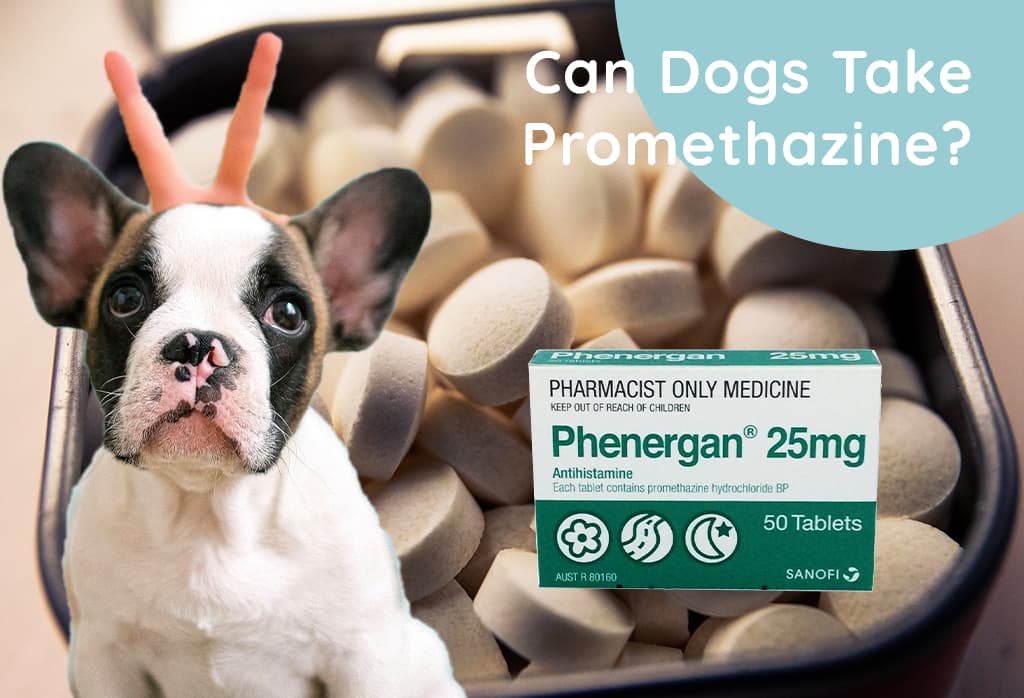So, you’ve heard about this thing called promethazine, and you’re wondering if it’s okay to give it to your dog.
Look, I get it, we want our pups to feel their best, and if they’re under the weather, we want to help.
This article is all about the mysterious promethazine, whether your canine companion can take it, and what to watch out for if they do.
Let’s dive in!
Can dogs take promethazine?
Now, let’s get the skinny on promethazine.
It’s a medication often used in humans for a variety of reasons.
Some of the biggies include allergies, motion sickness, and even as a pre-surgery sedative.
But when it comes to our four-legged besties, things can be a little more complicated.
So, let’s dig a little deeper and figure out if it’s safe for your pup.
Alright, let’s get a little research-y.
While there’s not a ton of research on promethazine specifically for dogs, there are some studies out there.
Some vets have used it to treat doggy motion sickness or even as a mild sedative before medical procedures.
But—and this is a big but—it’s important to remember that dogs aren’t just tiny humans.
They have their own unique physiology, which means that what’s safe for us might not be safe for them.
Risks and potential side effects of giving promethazine to dogs
Now let’s talk risks.
As with any medication, promethazine can come with some side effects.
In dogs, these might include drowsiness, dry mouth, and even a rapid heart rate.
And of course, there’s always the risk of an allergic reaction.
That’s something you definitely want to avoid when you’re trying to help your pup feel better!
There’s another thing to consider: dosage.
Because promethazine hasn’t been super well-studied in dogs, there isn’t a one-size-fits-all dosage.
That means that if you were to give your dog promethazine without consulting a vet, you’d be taking a pretty big risk.
And nobody wants to put their furry friend in harm’s way!
So, can dogs take promethazine? Well, it’s not a simple yes or no answer.
In some cases, it might be an option for your pup, especially if your vet gives you the green light.
But without professional guidance, it’s probably best to err on the side of caution and look for other ways to help your dog feel better.
What are the alternatives to promethazine for dogs?
Now that we’ve chatted about promethazine, it’s time to talk alternatives.
I mean, we all want to make sure our pups are happy and healthy, right? So let’s explore some options for those times when promethazine might not be the best choice for your furry sidekick.
We’ll dive into what these alternatives are and weigh the pros and cons of each one.
Buckle up, and let’s get started!
Diphenhydramine (Benadryl): This antihistamine is a popular choice for treating allergies in dogs.
It can help with itching, sneezing, and even mild cases of motion sickness.
Plus, it’s relatively safe and easy to find.
Meclizine (Bonine, Antivert): Another antihistamine, meclizine is specifically used to prevent and treat motion sickness in dogs.
It’s a good option if your pup gets a little queasy on car rides or other adventures.
Cerenia (maropitant citrate): This medication is specifically designed for dogs to treat motion sickness and vomiting.
It’s prescription-only, but it’s been shown to be super effective in our canine pals.
Ginger: If you’re looking for a more natural approach, ginger might be your new best friend.
It’s been used for centuries to combat nausea, and it can be helpful for dogs too.
Just be sure to check with your vet on the proper dosage.
Pros and cons of each alternative
Diphenhydramine (Benadryl)
Pros: Widely available, relatively safe, and effective for allergies and mild motion sickness
Cons: Can cause drowsiness and may not be suitable for all dogs
Meclizine (Bonine, Antivert)
Pros: Effective for motion sickness and relatively safe for dogs
Cons: May cause drowsiness and isn’t specifically designed for canines
Cerenia (maropitant citrate)
Pros: Specifically designed for dogs, highly effective for motion sickness and vomiting
Cons: Prescription-only and may be more expensive than over-the-counter options
Ginger
Pros: Natural alternative, safe for most dogs, and effective for mild cases of motion sickness
Cons: May not be as effective as other options, and proper dosage can be tricky
How is promethazine used in veterinary medicine?
Now, let’s circle back to promethazine for a hot second.
We’ve talked about whether it’s safe for dogs and some alternative options, but what about its actual use in veterinary medicine? Let’s dive in and see how vets might use promethazine for our furry friends.
Explanation of promethazine’s use in veterinary medicine
As we mentioned earlier, promethazine is primarily used in humans for things like allergies, motion sickness, and sedation.
In the world of veterinary medicine, it’s not quite as common.
However, some vets might choose to use it for dogs in certain situations, like to treat motion sickness or as a mild sedative.
Common conditions treated with promethazine in dogs
When it comes to using promethazine for dogs, there are a few specific situations where it might be helpful:
Motion sickness: Just like with humans, promethazine can help some dogs feel better during car rides or other situations where motion sickness might be an issue.
Sedation: In some cases, vets might use promethazine as a mild sedative for dogs undergoing minor procedures or exams.
Dosage and administration of promethazine for dogs
If your vet does decide that promethazine is the right choice for your dog, it’s essential to follow their recommendations for dosage and administration.
Because there isn’t a one-size-fits-all dosage for dogs, your vet will determine the right amount based on your pup’s weight, age, and specific needs.
Keep in mind that promethazine is typically available as a tablet, liquid, or suppository.
Your vet will let you know which form is best for your dog and give you instructions on how to administer it properly.
And remember, it’s super important to follow your vet’s guidance to the letter.
What are the side effects of promethazine in dogs?
Alright, we’ve talked about promethazine, its alternatives, and how it’s used in veterinary medicine.
But what about those pesky side effects? Let’s dive into the not-so-fun part of promethazine and see how it might affect our canine companions.
We’ll also chat about how to manage any side effects and when it’s time to call in the professionals (a.k.a., your trusty veterinarian).
First things first, let’s talk about the most common side effects that dogs might experience when taking promethazine:
Drowsiness: Just like with humans, promethazine can make dogs feel a little sleepy.
This might be okay for some situations, but it’s definitely something to keep an eye on.
Dry mouth: Dogs on promethazine might experience dry mouth, which can make them extra thirsty.
Be sure to have plenty of water available for your pup if they’re taking this medication.
Rapid heart rate: In some cases, promethazine can cause an increased heart rate in dogs.
This is something to watch out for, especially if your furry friend has any pre-existing heart conditions.
Allergic reactions: Though rare, dogs can have allergic reactions to promethazine.
This might show up as hives, difficulty breathing, or swelling.
If you notice any of these symptoms, contact your vet ASAP.
How to manage side effects
If your dog does experience any side effects from promethazine, there are a few things you can do to help:
Monitor your dog closely: Keep a close eye on your pup and take note of any changes in their behavior or symptoms.
Provide extra care and comfort: Make sure your dog has a comfy place to rest and lots of water to drink.
Follow your vet’s instructions: Your vet will likely give you specific guidance on how to manage side effects.
Be sure to follow their advice to keep your dog as comfortable as possible.
When to contact a veterinarian
If your dog’s side effects are severe, persistent, or worsening, it’s time to call your vet.
They can help you determine if promethazine is still the best choice for your pup or if it’s time to try a different approach.
Remember, your vet is your best resource when it comes to your dog’s health and well-being!
Can promethazine be given to dogs with certain conditions?
Now let’s chat about whether promethazine is a good option for dogs with specific conditions.
We’ll discuss when this medication might not be the best choice and what precautions to take if your dog has a pre-existing condition.
There are a few situations where promethazine might not be the best choice for your furry friend:
Dogs with heart conditions: As we mentioned earlier, promethazine can cause an increased heart rate, which might not be ideal for dogs with heart problems.
Dogs with respiratory issues: Promethazine can sometimes cause respiratory depression, so it’s generally not recommended for dogs with existing breathing issues.
Pregnant or nursing dogs: The safety of promethazine for pregnant or nursing dogs hasn’t been well studied, so it’s best to avoid it in these cases.
How to determine if promethazine is safe for your dog
The best way to figure out if promethazine is a good choice for your dog is to consult with your vet.
They can review your dog’s medical history, evaluate their current condition, and help you decide if promethazine is the right fit.
If your vet determines that promethazine is safe for your dog despite their pre-existing conditions, there are some precautions you can take to minimize potential risks:
Follow your vet’s guidance: Always follow your veterinarian’s advice on dosage and administration.
They may recommend a lower dose or more frequent monitoring for dogs with certain conditions.
Monitor your dog closely: Keep a watchful eye on your pup while they’re taking promethazine, and be on the lookout for any changes in their behavior or symptoms.
Keep open communication with your vet: Stay in touch with your veterinarian and report any concerns or changes in your dog’s condition.
They can help you decide if it’s necessary to adjust the treatment plan.
How to give promethazine to dogs?
Alright, let’s get down to the nitty-gritty – how do you actually give promethazine to your dog? We’ll talk about the different forms of promethazine available, how to administer it, and some handy tips to make the process a little smoother for both you and your furry friend.
Different forms of promethazine available for dogs
Promethazine comes in several forms, including:
Tablets: These can be given directly or hidden in a tasty treat to make it more appealing to your dog.
Liquid: This form can be measured with a dropper or syringe and given orally or mixed into your dog’s food.
Suppositories: These are administered rectally and can be a good option for dogs that refuse oral medications.
How to administer promethazine to dogs
Depending on the form of promethazine you’re using, there are a few ways to give it to your dog:
Tablets: You can give the tablet directly to your dog or hide it in a treat, like a soft piece of cheese or a bit of peanut butter (just make sure it’s xylitol-free!).
Liquid: To give the liquid form, measure the correct dose with a dropper or syringe, and then either squirt it directly into your dog’s mouth or mix it into their food.
Suppositories: To administer a suppository, you’ll need to gently insert it into your dog’s rectum.
This method might not be the most enjoyable for you or your dog, but it can be effective if other options aren’t working.
Tips on giving promethazine to dogs
Make it a positive experience: Reward your dog with praise, pets, or a favorite toy after they’ve taken their medication.
Stay calm and patient: Your dog can sense your emotions, so try to keep things relaxed and low-key.
Ask your vet for advice: If you’re struggling with giving promethazine to your dog, don’t hesitate to reach out to your vet for suggestions and guidance.
Frequently Asked Questions
Now let’s tackle some common questions and concerns about promethazine and dogs.
Here are some expert answers to help put your mind at ease.
Can I give my dog promethazine for anxiety?
While promethazine has sedative effects, it’s not specifically designed to treat anxiety in dogs.
Consult with your veterinarian for appropriate anti-anxiety medications or alternative treatments.
How long does promethazine take to work in dogs?
The time it takes for promethazine to work can vary depending on factors like your dog’s size and metabolism.
Generally, it can take anywhere from 30 minutes to an hour for the medication to start working.
Conclusion
So, let’s do a quick recap of the main points we’ve covered in this blog post.
We talked about what promethazine is, whether dogs can take it, its side effects, and alternative options.
We also discussed how to administer promethazine and answered some frequently asked questions.
In summary, promethazine can be given to dogs in certain situations and under the guidance of a veterinarian.
However, it’s important to consider alternative options and consult your vet before giving your dog any new medication.
If you’re considering giving promethazine to your dog, remember that it’s crucial to consult with your veterinarian first.
They can help you decide if it’s the right choice for your pup and provide specific guidance on dosage and administration.
After all, when it comes to our furry friends, we always want to make sure we’re doing what’s best for them.
Stay paws-itive and keep your dog’s best interests at heart!
In the end, the most important thing is to prioritize your dog’s health and well-being.
While promethazine might be helpful in some cases, it’s not a one-size-fits-all solution, and other alternatives may be better suited for your dog’s needs.
Always consult with your veterinarian before giving any medication to your dog, and make sure to closely monitor them for any changes in their behavior or symptoms.













